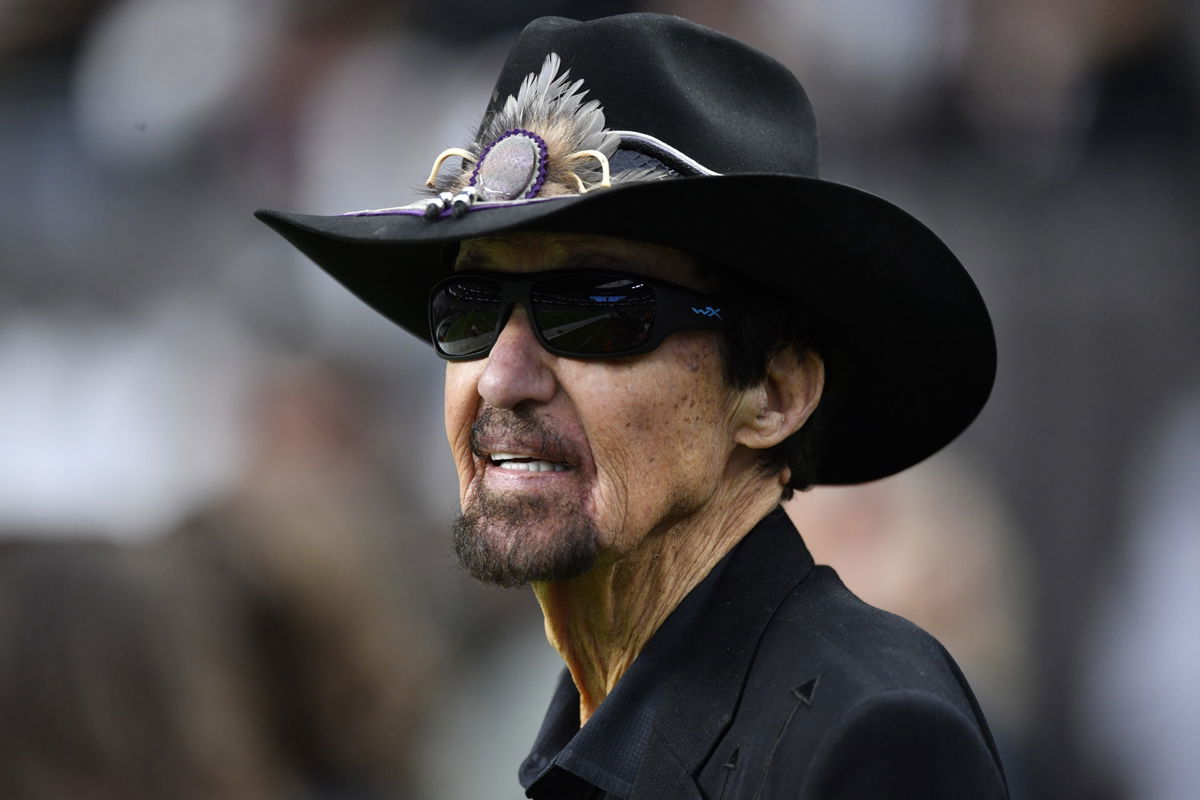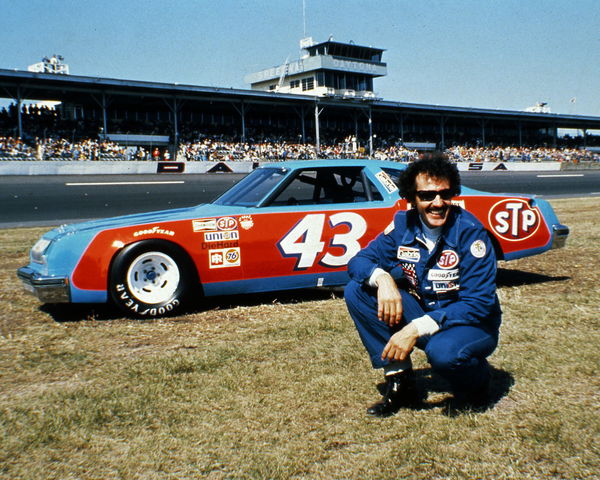
Getty
LAS VEGAS, NEVADA – DECEMBER 05: NASCAR Hall of Famer Richard Petty looks on before a game between the Las Vegas Raiders and Washington Football Team at Allegiant Stadium on December 05, 2021 in Las Vegas, Nevada. (Photo by Chris Unger/Getty Images)

Getty
LAS VEGAS, NEVADA – DECEMBER 05: NASCAR Hall of Famer Richard Petty looks on before a game between the Las Vegas Raiders and Washington Football Team at Allegiant Stadium on December 05, 2021 in Las Vegas, Nevada. (Photo by Chris Unger/Getty Images)
When you talk about Richard Petty, the first thing that comes to mind is the seven championship wins, a NASCAR legacy, and multiple records etched to his name. In a true sense, he was a pioneer in uplifting stock car racing to the mainstream level. However, his biggest contribution to the sport isn’t his accolades but a masterstroke that revived NASCAR’s economic model for years to come.
Watch What’s Trending Now!
His association with STP and Andy Granatelli ushered in the era of national sponsorship for the first time in the history of NASCAR. However, the deal with STP was everything but a smooth ride—the nostalgic details of which were brought to light by the King himself…
ADVERTISEMENT
Here’s how the iconic Blue-Red #43 car came into existence
In 1971, NASCAR was under a period of transition, and the teams were finding it hard to survive financially. Even three-time champion Petty and his team, Petty Enterprises, weren’t able to tackle this crisis. They had lost out on their OEM partners; Ford took an exit, while Chrysler was leaving the team too. NASCAR took steps to help the teams survive; they shortened the race schedule and increased the purse, but it wasn’t enough.
Interestingly, Granatelli, the CEO of STP at the time, kept a close eye on NASCAR after his success in IndyCar. He identified Petty Enterprises as a perfect avenue to start a new partnership, one that would change stock car racing forever. In November of ’71, the businessman casually strolled into the Petty Enterprises garage and introduced himself. Another phone call invitation later, in 1972, Richard Petty and his entourage headed to Chicago at the STP headquarters to crack the deal, as his team made its way to Riverside International Raceway in California to prepare for the first race of the season.
Taking a stroll back memory lane, Petty recalled how the deal came about with STP. “So we went in and was going to sit down and talk to Granatelli about sponsorship. We sat there for a little while and everything kind of worked out, and I think he was going to pay us $250,000 or something, and you know we never had a sponsor, so. You might’ve had a local dealership or something on the side of your car, but nothing that went nationwide. That was like money just falling out of sky,” he said while speaking to NASCAR.
ADVERTISEMENT
However, there was one issue. Granatelli wanted the #43 car to be red—reflective of his STP brand. But Petty wasn’t going to change his team’s brand identity overnight. Ultimately, the two parties brokered a deal and decided to go half red and half blue, colors that represent the NASCAR icon to this date. “He said, “Okay, the cars will be day glow red because that’s my color, and I said, ‘No way, our cars have always been blue and they’re going to stay blue.'[laughing] He offered me $50,000 more if we painted the thing red, and I said no.”
But the refusal wasn’t on a whim. It was a calculated and personal business decision. “We had always been the brand. I mean, you know, Petty Enterprises, a blue car, so we had a following and had a sort of a base for Petty Enterprises. So we looked at it and said, ‘Okay, if we paint this thing red, we’re not Petty Enterprises anymore. We’re we’re a different company,’ and I said no,” the iconic veteran said, before adding, “We stayed overnight and talked to Granatelli and his PR people. So we sat down and said, Okay, we’ll do half and half.”
ADVERTISEMENT
On that same day 52 years ago, Granatelli also made a heartfelt promise that saw the light of day before the businessman’s passing in 2013: “Stick with me,” he had told Petty, “and one day you’ll be as famous as I am.”
Who knew a color that was discovered by the Petty brothers accidentally would carry so much significance? To sum up the hilarious incident: One late night (at around 2 or 3 in the morning), the King and his brother Maurice were painting the family racecar as instructed by their father and racer Lee Petty. However, they encountered a problem. The color white, which their father usually ran, was sparse. Realizing the amount of paint left wouldn’t cover the entire car, the brothers dumped some blue paint lying nearby into the white one. “The mixture started life as ’57 Chevrolet White, which is Refrigerator White, and ’55 Dodge Blue, which is Indigo Blue…When it was finished, we said ‘Man, that’s pretty!’” the King had told Mopar Muscle in an interview.

Getty
DAYTONA BEACH, FL – 1979: Richard Petty rallied late in the season to gain the advantage and win an unprecedented seventh national title in NASCAR’s Cup Series. (Photo by ISC Archives/CQ-Roll Call Group via Getty Images)
Notably, the aftermath of the partnership wasn’t just beneficial to the two parties involved, but the whole sport. As per NASCAR team owner, Jack Roush, “When Richard did the STP sponsorship deal it forever changed the business model in American motorsports…At a time when a lot of people were panicking about money, not unlike today, he and that company presented a solution that changed the face of racing.”
ADVERTISEMENT
As for Petty, he was advised to be wary of Andy Granatelli and his ingenious plans that could alter his racing legacy. But, instead, this partnership created history and paved the way for how teams would operate across the three series in NASCAR.
Top Stories
Florida Police Arrest Millionaire NASCAR Veteran Over Disturbing Public Misbehavior

Richard Childress’ Grandson to Be the ‘First Casualty’ of RCR-Kaulig Racing Divorce, Claims Dale Jr.

Dale Jr & JRM’s Cup Dreams in Shambles as NASCAR Charters Break $100M Barrier

When an American Legend Confessed to His Long Kept Promise to Dale Earnhardt That He Still Honors

Kyle Larson Declares 7-YO Daughter Audrey’s Talent “Better Than Mine” After Red Bluff Triumph

ADVERTISEMENT
Petty’s friends at IndyCar had warned him about working with Granatelli
Now, Andy Granatelli looked like an intimidating personality that resembled a character from Martin Scorsese’s films. He was a Texas native and was a gearhead, like most folks in NASCAR. However, before his partnership with Petty Enterprises, he achieved success at the IndyCar level. The likes of Joe Leonard and Parnelli Jones drove the bright red STP-sponsored race cars. But his victory with Mario Andretti at the Indy 500 in 1969 is still a part of motorsports folklore.
But Granatelli knew about the potential of NASCAR and didn’t think twice about forging ties with the superstar driver, Richard Petty. Although Petty was warned about the downside of working with Granatelli, he placed his trust in him. “We had talked to some of the IndyCar people that had worked with him and been around him, and they said he’ll come in and screw your whole situation up because he’ll start telling you what to do and how to do it. And I said no, he won’t, and he never did.” Petty explained.
Granatelli, on the other hand, couldn’t be more appreciative of the deal. “He was the best…He’s a gentleman’s gentleman. Nobody didn’t like Richard,” the STP CEO had said in 2011.
ADVERTISEMENT
If anything, it was STP and Granatelli who were the big winners. After their association with Petty, their products were not only marketed in the U.S. and Mexico, but also across 100 countries around the globe.
ADVERTISEMENT
ADVERTISEMENT
ADVERTISEMENT

